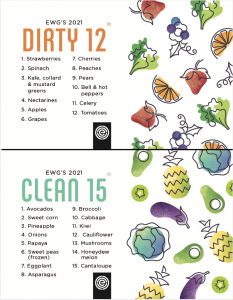2.4 The Environmental Working Group’s Dirty Dozen and Clean Fifteen

The Environmental Working Group (EWG)1 develops a Dirty Dozen2 and Clean 153 list annually of the produce with the highest levels of pesticide residue and the produce with the lowest levels. This information is helpful when shopping with a budget as organic produce is often more expensive.
Ways to Support Environmental Sustainability
Eat Local4
Although there are no standard definitions for “Locally Grown,” focus on eating fruits and vegetables that are in season and labeled locally sourced. This way, the food you are consuming spends less time being transported and is at its peak of nutrition and flavor. Foods sold in grocery stores travel on average 1,500 miles using energy, fuel and require special packaging that will eventually be added to landfills. (Arizona Specialty Crop Guide)
Home Gardening5: Growing your own foods allows you to have control of all aspects of the fruits and vegetables you eat. Home gardens are not only possible in homes that have land, but also in small urban spaces in containers.
Community Gardens6: Getting involved with a community garden is another way to grow more sustainable produce. Being a part of a community garden provides the added benefit of not only sharing produce but also sharing ideas through the creation of a community.
Farmer’s Markets7: Farmer’s markets give people the chance to interact directly with local farmers and ask questions about production methods and the foods they grow. It is important to note that not all of the products at a local farmer’s market may be local; some vendors may sell products from commercial markets.
By purchasing directly from farmers, the farmer is able to retain all of the retail value of the products by not having to pay a seller, and this ultimately helps the farmer continue farming. Supporting local farmers and keeping them in business also helps to reduce the need for the farmer to sell off land to land developers.
Tips When Visiting Farmer’s Markets:
- Bring your own bags
- Keep an eye out for cleanliness and food safety
- Know what’s in season and preview the market’s website before visiting
- Talk to the growers and farmers
Community Supported Agriculture (CSA)8: Another way to purchase local produce is through a CSA membership. On a regular basis, weekly or bi-weekly for example, farmers provide a box of seasonal products for a prepaid membership fee to consumers that can be picked up by the consumer at a predetermined location, such as at the weekly farmer’s market.
Purchasing “Ugly” Produce, or produce that is misshapen or blemished is a way to reduce food waste. These fruits and vegetables hold the same nutritional value as those that are not perceived as flawed.
Looking Towards the Future
“Regenerative Agriculture”
According to Foodprint.org, regenerative agriculture takes sustainable agriculture to the next level; it is a necessary step in addressing problems of topsoil loss and climate change. In fact, efforts regarding regenerative agriculture are being made by top food brands, such as General Mills, and there is a new certification being developed, the Regenerative Organic Certification.
“Dr. Urvashi Rangan, Chief Science Advisor for FoodPrint, calls regenerative agriculture “organic plus.” As she puts it, “It’s the next iteration of sustainable agriculture.” Sustainable farming practices aim to use only the resources that are available; regenerative agriculture focuses on actively “building health into the system,” beginning with increasing soil fertility. Regenerative agriculture is a holistic systems approach that starts with the soil, and also includes the health of the animals, farmers, workers, and community.
“What is Regenerative Agriculture,” Foodprint.org

